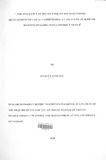| dc.description.abstract | The purpose of this study was to investigate the influence of relief food dependency on the socio-economic development of the local communities in Sericho Division of Garba Tulia District in Eastern province. The sample size consisted of three aid agencies directors, one district officer, five chiefs and one hundred and twenty households' heads. The respondents were sampled from Sericho division of Garba Tulia District. purposive, Stratified and simple random sampling methods of sampling were applied to pick the required sample size for the study from the targeted population.
Data was collected by use of two instruments. These included interview schedules for relief aid agencies and district officers and questionnaires for chiefs and local house hold heads. The instruments were used to collect data conceming the relief food dependency and its influence on the socio-economic development of households among local communities. The data collected was analyzed by use of frequency tables and percentages. The researcher presented the analyzed data by use of tables. The study established that among the factors influencing relief food dependency, extreme poverty and extended drought were the main factors attracting 25% response each from respondents.
It also established that, the main impact of relief food dependency was lowering of grain prices and poor business for the local farmers and improvement of trade for livestock farmers with 25% response from aid agency officers, 16.67% from local chiefs and 24.10 % from household heads. Pastoralism emerged as the main alternative economic activity recording 38-42 % response from all respondents. lnfrastructural facilities present which measure development included schools, polytechnic! colleges, health services, water resources and sports which all the respondents concurred that were in poor condition and needed improvement.
The researcher recommends that, politics whether global, regional or national should reflect a genuine desire to break relief food dependency cycle. Measures of intervention should aim at improving welfare of recipient as well as building their coping capacity. Governments and donors agencies should make efforts to improve pastoralism as the main alternative economic activity.
In conclusion, dependency on relief food supplies need to be reduced and more development focused approach employed if it is to be a useful avenue of bnilding disaster stricken peoples initiatives. | en_US |

